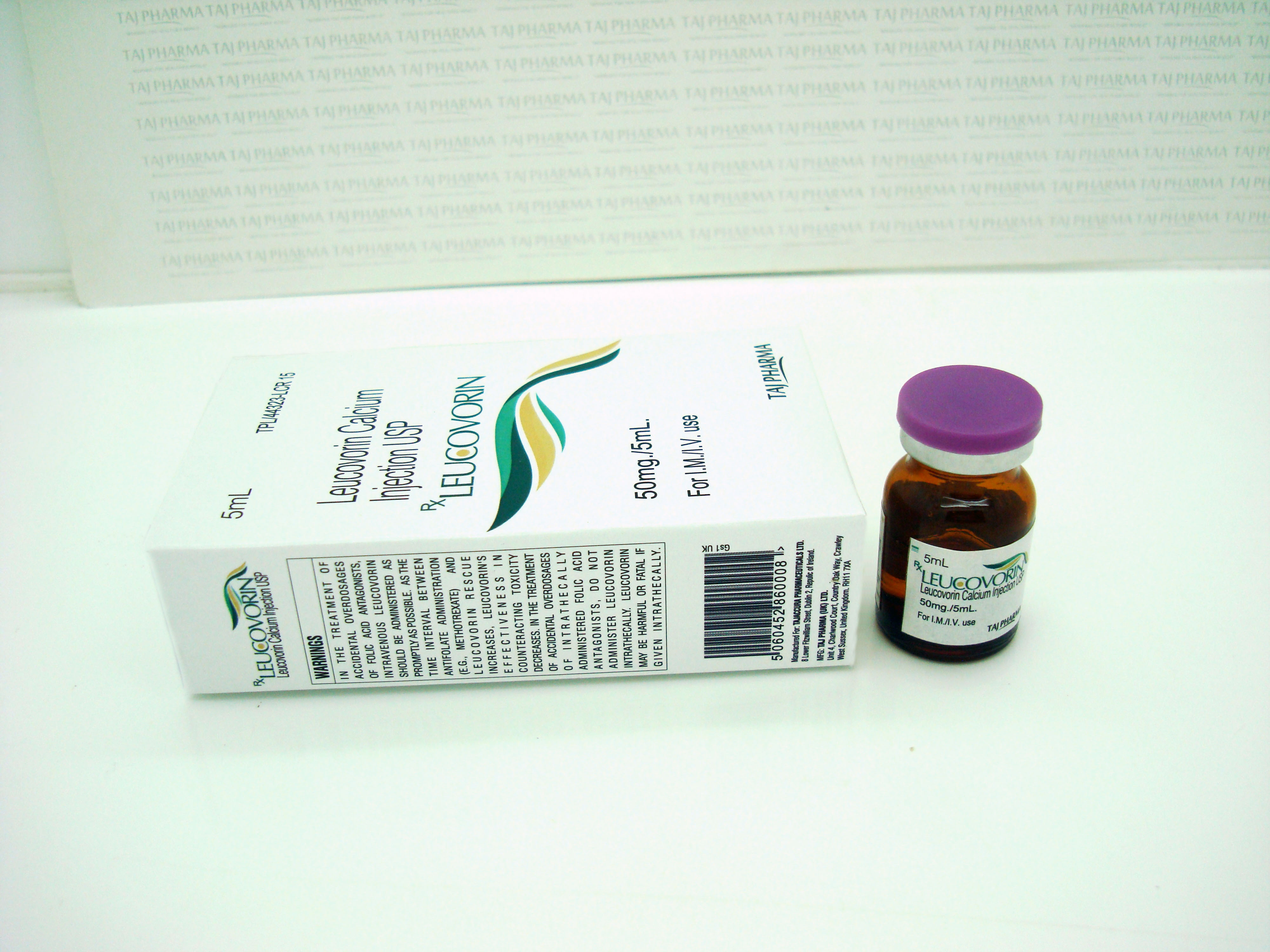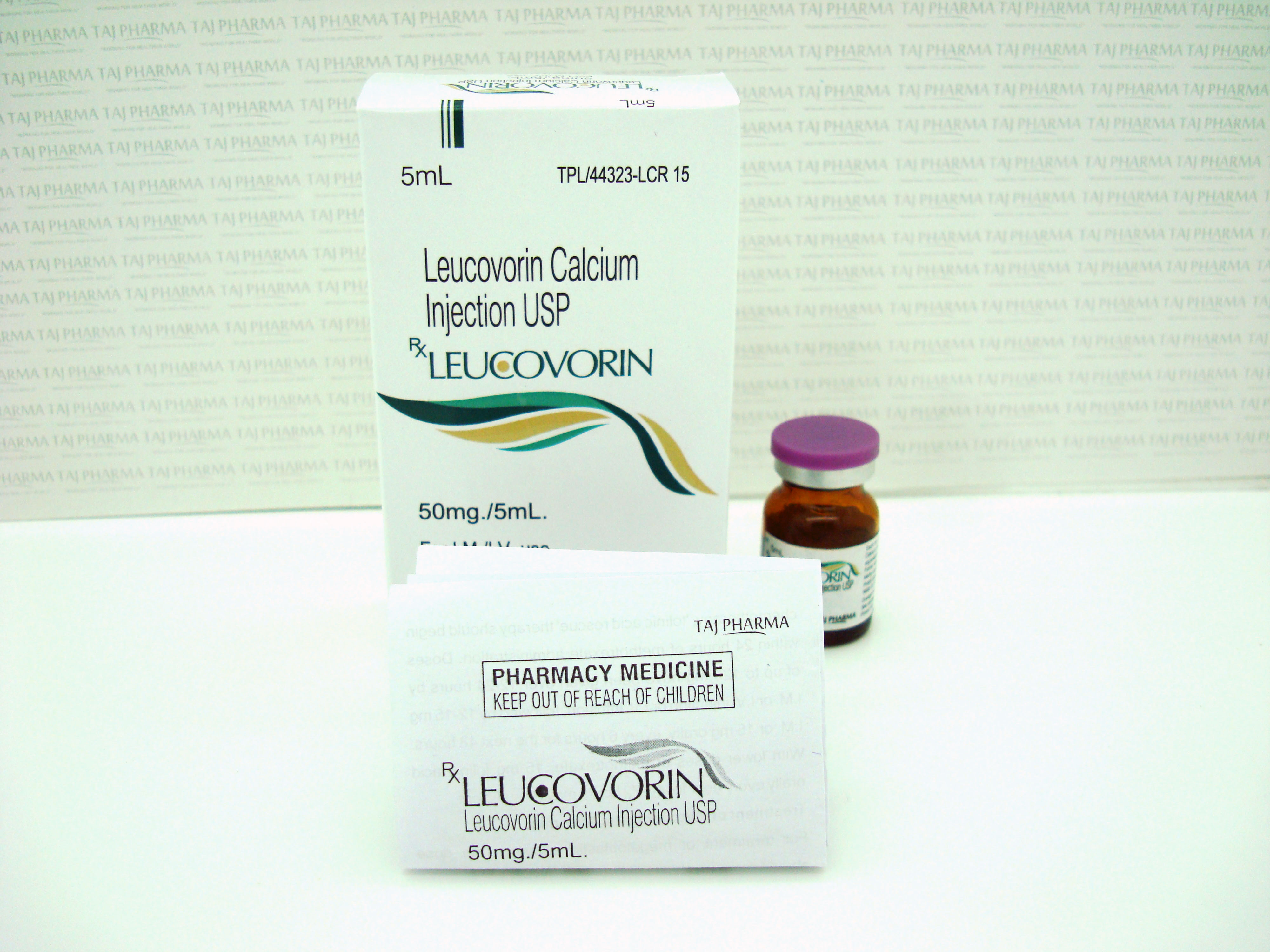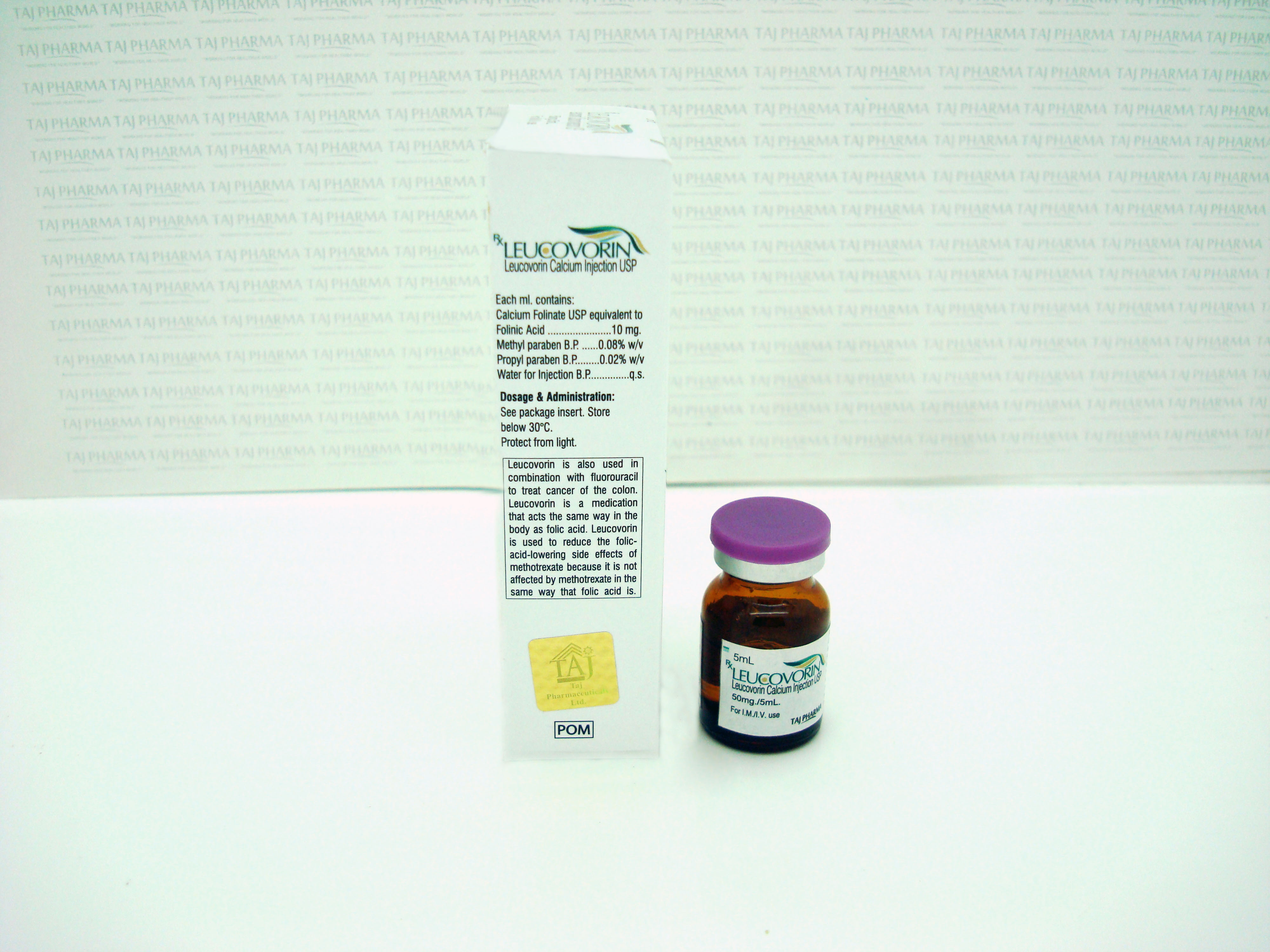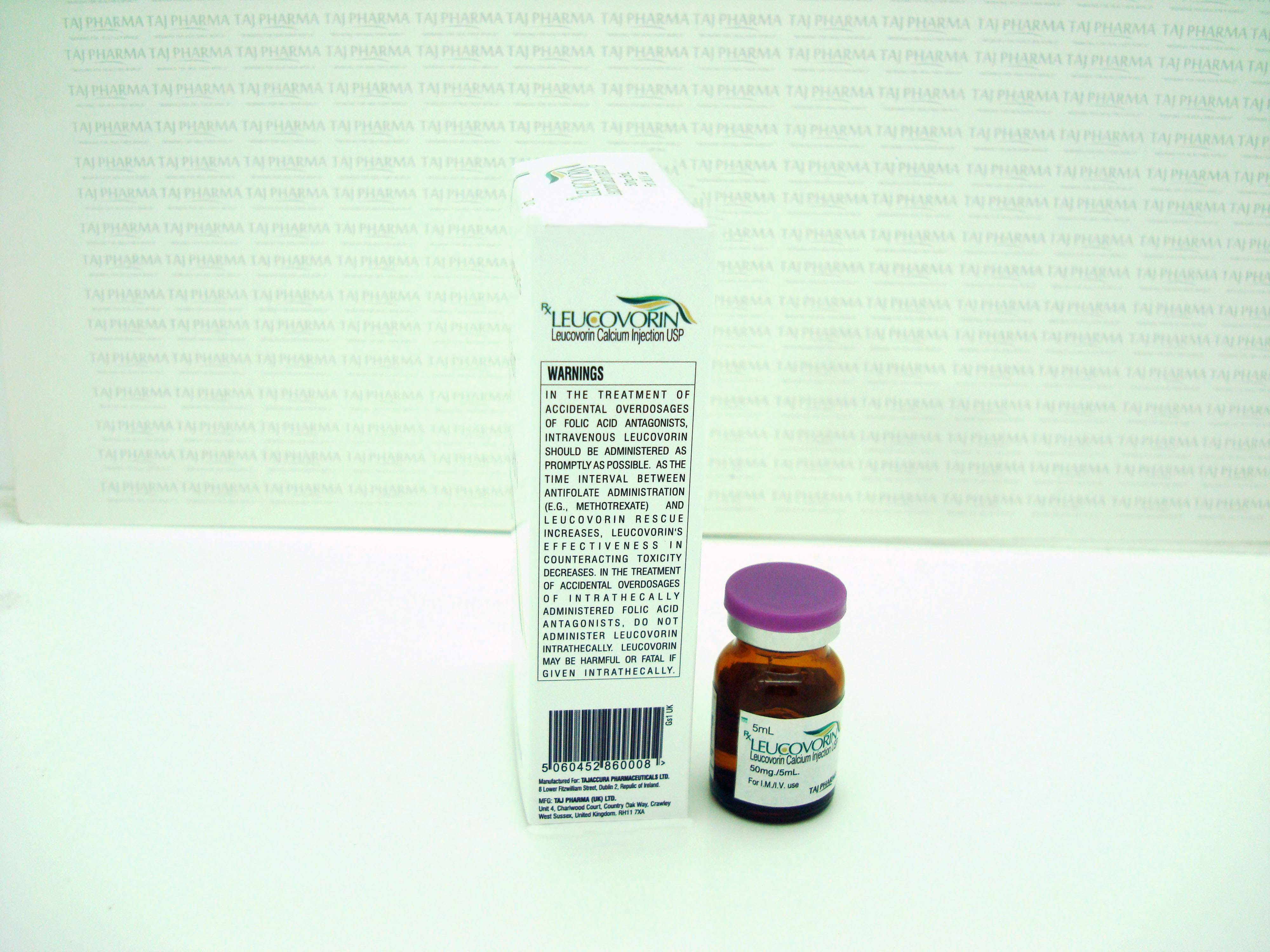Leucovorin Calcium 50mg/Vial,100mg/Vial Injection
Leucovorin Calcium
Leucovorin Calcium 50mg/Vial,100mg/Vial Injection
Leucovorin Calcium Injection, USP, 10 mg/mL, is supplied in sterile, single use vials as follows:
500 mg individually-boxed.
Store in refrigerator 2° to 8°C (36° to 46°F). Protect from light. Discard unused portion. Retain in carton until time of use.
Leucovorin Calcium for Injection is supplied in sterile, single use vials as follows:
50 mg boxed vial, packs of 10.
100 mg boxed vial, packs of 10.
200 mg boxed vial.
350 mg boxed vial.
Store at 20° to 25°C (68° to 77° F) [See USP Controlled Room Temperature]. Protect from light. Retain in carton until time of use.
Leucovorin calcium rescue is indicated after high dose methotrexate therapy in osteosarcoma. Leucovorin calcium is also indicated to diminish the toxicity and counteract the effects of impaired methotrexate elimination and of inadvertent overdosages of folic acid antagonists.
Leucovorin calcium is indicated in the treatment of megaloblastic anemias due to folic acid deficiency when oral therapy is not feasible.
Leucovorin is also indicated for use in combination with 5-fluorouracil to prolong survival in the palliative treatment of patients with advanced colorectal cancer. Leucovorin should not be mixed in the same infusion as 5-fluorouracil because a precipitate may form.
Leucovorin Calcium 50mg/Vial,100mg/Vial Injection
What is in this leaflet?
- This leaflet answers some common questions about Leucovorin Calcium Injection. It does not contain all the available information. It does not take the place of talking to your doctor or pharmacist.
- All medicines have benefits and risks. Your doctor has weighed the risks of you taking Leucovorin Calcium Injection against the benefits this medicine is expected to have for you.
- This medicine is likely to be used while you are at the clinic or in hospital. If possible, please read this leaflet carefully before this medicine is given to you. In some cases this leaflet may be given to you after the medicine has been used.
If you have any concerns about taking this medicine, ask your doctor or pharmacist.
Keep this leaflet.
You may need to read it again
What Leucovorin Calcium Injection is used for?
Leucovorin Calcium Injection contains calcium folinate. It belongs to a group of vitamins used as an antidote to the harmful effects of methotrexate therapy. Calcium folinate acts in the same way as folic acid which may be low in these patients Leucovorin Calcium Injection may be used for the management of other conditions that are not mentioned above.
Your doctor will be able to tell you about the specific condition for which you have been prescribed Leucovorin Calcium Injection.
Before you are given Leucovorin Calcium Injection
When you must not be given it
Do not have Leucovorin Calcium Injection if you have an allergy to:
- any medicine containing leucovorin calcium (calcium folinate or folinic acid)
- any of the ingredients listed at the end of this leaflet
- any similar medicines.
You must not be given Leucovorin Calcium if you have or have had any of the following medical conditions:
- pernicious anaemia
- any other megaloblastic anaemias which are due to a lack of Vitamin B12.
Before you are given it
Tell your doctor if:
You have any allergies to:
- any other medicine
- any other substances, such as foods, preservatives or dyes
You are pregnant or intend to become pregnant
You are breastfeeding or plan to breastfeed
You have or have had any medical conditions, especially the following:
- fits or convulsions (epilepsy)
- Vitamin B12 deficiency
- cancer which has spread to other parts of the body such as the brain
Taking other medicines
Tell your doctor if you are taking any other medicines, including:
- all prescription medicines
- all medicines, vitamins, herbal supplements or natural therapies you buy without a prescription from a pharmacy, supermarket, naturopath or health food shop
Some medicines may be affected by Leucovorin Calcium Injection, or may affect how well it works. You may need different amounts of your medicine, or you may need to take different medicines. Your doctor will advise you.
Tell your doctor or pharmacist if you are taking any of the following:
- medicines used to treat cancer, such as fluorouracil
- medicines to treat epilepsy (fits), such as phenobarbitone, phenytoin, primidone, succinimides.
- medicines such as co- trimoxazole, pyrimethamine.
Your doctor and pharmacist have more information on medicines to be careful with or avoid while taking this medicine.
How Leucovorin Calcium Injection is given
Leucovorin Calcium Injection is given by injection into the veins or muscle, usually 24 hours after the methotrexate was given. Leucovorin Calcium Injection must only be given by a doctor or nurse.
Your doctor will decide which strength of Leucovorin Calcium Injection you need and how much you need to be given. This will depend on any previous treatment you have had and any current treatment you are taking.
If you are given too much (overdose)
If you are given too much folinic acid, you may experience some of the effects listed under "Side Effects" below.
Your doctor has information on how to recognise and treat an overdose. Ask your doctor if you have any concerns.
While you are having Leucovorin Calcium Injection
Things you must do
If you are about to be started on any new medicine, remind your doctor and pharmacist that you have been given Leucovorin Calcium Injection.
Tell any other doctors, dentists, and pharmacists who treat you that you are taking this medicine.
If you are going to have surgery, tell the surgeon or anaesthetist that you have been given this medicine
It may affect other medicines used during surgery.
If you become pregnant while while taking this medicine, tell your doctor immediately
If you are about to have any blood tests, tell your doctor that you have been given this medicine.
It may interfere with the results of some tests.
Keep all of your doctor’s appointments so that your progress can be checked.
Your doctor may do some tests on your blood and urine to make sure the medicine is working.
Things you must not do
Do not have Leucovorin Calcium Injection to treat any other complaints unless your doctor tells you to.
Do not give your medicine to anyone else, even if they have the same condition as you.
Things to be careful of
Be careful driving or operating machinery until you know how Leucovorin Calcium Injection affects you.
This medicine may cause fainting or seizures in some people. If you have any of these symptoms, do not drive operate machinery or do anything else that could be dangerous
If you feel light-headed, dizzy or faint when getting out of bed or standing up, get up slowly.
Standing up slowly, especially when you get up from bed or chairs, will help your body get used to the change in position and blood pressure. If this problem continues or gets worse, talk to your doctor.
Side effects
Tell your doctor, nurse or pharmacist as soon as possible if you do not feel well while you are having Leucovorin Calcium Injection.
All medicines can have side effects. Sometimes they are serious, most of the time they are not. You may needmedical attention if you get some of the side effects.
It can be difficult to tell whether side effects are the result of being given Leucovorin Calcium Injection, effects of your condition or side effects of other medicines you may be taking. For this reason it is important to tell your doctor of any change in your condition.
Do not be alarmed by the list of side effects.
You may not experience any of them
Ask your doctor or pharmacist to answer any questions that you may have.
Tell your doctor if
Tell your doctor if you notice any of the following and they worry you:
- skin rash
- diarrhoea
- nausea and vomiting
The above list includes the more common side effects of your medicine. They are usually mild and short-lived.
Tell your doctor as soon as possible if
Tell your doctor as soon as possible if you notice any of the following:
- persistent or severe diarrhoea
- sore mouth, throat or stomach
- fever
- redness, pain or peeling of skin on the hands or feet
The above list includes serious side effects that may require medical attention.
Go to hospital if
Tell your doctor immediately or go to Accident and Emergency at your nearest hospital, if you notice any of the following:
- seizures, fits or fainting
- allergies:
The above list includes very serious side effects. You may need urgent medical attention or hospitalisation.
Some people develop an allergy to Leucovorin Calcium Injection; this may appear as an itchy rash or high temperature after the injection. If you experience this, or a swelling of the face, lips, tongue or throat, and/or difficulty in breathing, you should inform the doctor or nurse immediately.
Tell your doctor ifyou notice anything else that is making you feel unwell.
Other side effects not listed above may also occur in some patients. If you notice any other effects, check with your doctor.
Some of these side effects can only be found when your doctor does tests from time to time to check your progress.
Product description
What it looks like
Leucovorin Calcium Injection is a clear, yellowish solution.
Steriluer ampoule:
Leucovorin Calcium Injection 50 mg (folinic acid) in 5 mL (sterile)
Leucovorin Calcium Injection 100 mg (folinic acid) in 10 mL (sterile)
Ingredients
Leucovorin CalciumInjection contains calcium folinate in water for injections containing sodium chloride. It does not contain any preservatives.
Leucovorin Calcium 50mg/Vial,100mg/Vial Injection
DESCRIPTION
Leucovorin is one of several active, chemically reduced derivatives of folic acid. It is useful as an antidote to drugs which act as folic acid antagonists.
Also known as folinic acid, Citrovorum factor, or 5-formyl-5,6,7,8-tetrahydrofolic acid, this compound has the chemical designation of Calcium N-[p-[[[(6RS)-2-amino-5-formyl-5,6,7,8-tetrahydro-4-hydroxy-6-pteridinyl]methyl]amino]benzoyl]-L-glutamate (1:1). The structural formula of leucovorin calcium is:

C20H21CaN7O7 M.W.=511.51
Leucovorin Calcium Injection, USP is a sterile, preservative-free solution indicated for intramuscular (IM) or intravenous (IV) administration in a 50 mL single-dose vial. Each mL contains leucovorin calcium equivalent to 10 mg Leucovorin, USP; 8 mg sodium chloride; sodium hydroxide and/or hydrochloric acid for pH adjustment pH 7.8 (6.5 to 8.5).
There is 0.004 mEq of calcium per mg of leucovorin. Solution contains no bacteriostat or antimicrobial agents.
Leucovorin Calcium for Injection is a sterile product indicated for intramuscular (IM) or intravenous (IV) administration and is supplied in 50 mg, 100 mg, 200 mg, and 350 mg vials.
Each 50 mg vial of Leucovorin Calcium for Injection, when reconstituted with 5 mL of sterile diluent, contains leucovorin (as the calcium salt) 10 mg/mL.
Each 100 mg vial of Leucovorin Calcium for Injection, when reconstituted with 10 mL of sterile diluent, contains leucovorin (as the calcium salt) 10 mg/mL.
Each 200 mg vial of Leucovorin Calcium for Injection, when reconstituted with 20 mL of sterile diluent, contains leucovorin (as the calcium salt) 10 mg/mL.
Each 350 mg vial of Leucovorin Calcium for Injection, when reconstituted with 17.5 mL of sterile diluent, contains leucovorin (as the calcium salt) 20 mg/mL. Sodium hydroxide and/or hydrochloric acid may be added for pH adjustment. pH adjusted to 7.0 to 8.5.
In each dosage form, one milligram of leucovorin calcium contains 0.002 mmol of leucovorin and 0.002 mmol of calcium.
These lyophilized products contain no preservative. The inactive ingredient is Sodium Chloride, added to adjust tonicity. Reconstitute with Bacteriostatic Water for Injection, which contains benzyl alcohol, or with Sterile Water for Injection.
CLINICAL PHARMACOLOGY
Leucovorin is a mixture of the diastereoisomers of the 5-formyl derivative of tetrahydrofolic acid (THF). The biologically active compound of the mixture is the (-)-l-isomer, known as Citrovorum factor or (-)-folinic acid. Leucovorin does not require reduction by the enzyme dihydrofolate reductase in order to participate in reactions utilizing folates as a source of “one-carbon” moieties. l-Leucovorin (l-5-formyltetrahydrofolate) is rapidly metabolized (via 5, 10-methenyltetrahydrofolate then 5, 10-methylenetetrahydrofolate) to l,5-methyltetrahydrofolate. l,5-Methyltetrahydrofolate can in turn be metabolized via other pathways back to 5,10-methylenetetrahydrofolate, which is converted to 5-methyltetrahydrofolate by an irreversible, enzyme catalyzed reduction using the cofactors FADH2 and NADPH.
Administration of leucovorin can counteract the therapeutic and toxic effects of folic acid antagonists such as methotrexate, which act by inhibiting dihydrofolate reductase.
In contrast, leucovorin can enhance the therapeutic and toxic effects of fluoropyrimidines used in cancer therapy, such as 5-fluorouracil. Concurrent administration of leucovorin does not appear to alter the plasma pharmacokinetics of 5-fluorouracil. 5-Fluorouracil is metabolized to fluorodeoxyuridylic acid, which binds to and inhibits the enzyme thymidylate synthase (an enzyme important in DNA repair and replication).
Leucovorin is readily converted to another reduced folate, 5,10-methylenetetrahydrofolate, which acts to stabilize the binding of fluorodeoxyridylic acid to thymidylate synthase and thereby enhances the inhibition of this enzyme.
The pharmacokinetics after intravenous, intramuscular and oral administration of a 25 mg dose of leucovorin were studied in male volunteers. After intravenous administration, serum total reduced folates (as measured by Lactobacillus casei assay) reached a mean peak of 1259 ng/mL (range 897 to 1625). The mean time to peak was 10 minutes. This initial rise in total reduced folates was primarily due to the parent compound 5-formyl-THF (measured by Streptococcus faecalis assay) which rose to 1206 ng/mL at 10 minutes. A sharp drop in parent compound followed and coincided with the appearance of the active metabolite 5-methyl-THF which became the predominant circulating form of the drug.
The mean peak of 5-methyl-THF was 258 ng/mL and occurred at 1.3 hours. The terminal half-life for total reduced folates was 6.2 hours. The area under the concentration versus time curves (AUCs) for l-leucovorin, d-leucovorin and 5-methyltetrahydrofolate were 28.4 ± 3.5, 956 ± 97 and 129 ± 12 (mg/min/L ± S.E.). When a higher dose of d,l-leucovorin (200 mg/m2) was used, similar results were obtained. The d-isomer persisted in plasma at concentrations greatly exceeding those of the l-isomer.
After intramuscular injection, the mean peak of serum total reduced folates was 436 ng/mL (range 240 to 725) and occurred at 52 minutes. Similar to IV administration, the initial sharp rise was due to the parent compound. The mean peak of 5-formyl-THF was 360 ng/mL and occurred at 28 minutes. The level of the metabolite 5-methyl-THF increased subsequently over time until at 1.5 hours it represented 50% of the circulating total folates. The mean peak of 5-methyl-THF was 226 ng/mL at 2.8 hours. The terminal half-life of total reduced folates was 6.2 hours. There was no difference of statistical significance between IM and IV administration in the AUC for total reduced folates, 5-formyl-THF, or 5-methyl-THF.
After oral administration of leucovorin reconstituted with aromatic elixir, the mean peak concentration of serum total reduced folates was 393 ng/mL (range 160 to 550). The mean time to peak was 2.3 hours and the terminal half-life was 5.7 hours. The major component was the metabolite 5-methyltetrahydrofolate to which leucovorin is primarily converted in the intestinal mucosa. The mean peak of 5-methyl-THF was 367 ng/mL at 2.4 hours. The peak level of the parent compound was 51 ng/mL at 1.2 hours. The AUC of total reduced folates after oral administration of the 25 mg dose was 92% of the AUC after intravenous administration.
Following oral administration, leucovorin is rapidly absorbed and expands the serum pool of reduced folates. At a dose of 25 mg, almost 100% of the l-isomer but only 20% of the d-isomer is absorbed. Oral absorption of leucovorin is saturable at doses above 25 mg. The apparent bioavailability of leucovorin was 97% for 25 mg, 75% for 50 mg, and 37% for 100 mg.
In a randomized clinical study conducted by the Mayo Clinic and the North Central Cancer Treatment Group (Mayo/NCCTG) in patients with advanced metastatic colorectal cancer three treatment regimens were compared: Leucovorin (LV) 200 mg/m2 and 5-fluorouracil (5-FU) 370 mg/m2 versus LV 20 mg/m2 and 5-FU 425 mg/m2 versus 5-FU 500 mg/m2. All drugs were administered by slow intravenous infusion daily for 5 days repeated every 28 to 35 days. Response rates were 26% (p=0.04 versus 5-FU alone), 43% (p=0.001 versus 5-FU alone) and 10% for the high dose leucovorin, low dose leucovorin and 5-FU alone groups respectively. Respective median survival times were 12.2 months (p=0.037), 12 months (p=0.050), and 7.7 months. The low dose LV regimen gave a statistically significant improvement in weight gain of more than 5%, relief of symptoms, and improvement in performance status. The high dose LV regimen gave a statistically significant improvement in performance status and trended toward improvement in weight gain and in relief of symptoms but these were not statistically significant.
In a second Mayo/NCCTG randomized clinical study the 5-FU alone arm was replaced by a regimen of sequentially administered methotrexate (MTX), 5-FU, and LV. Response rates with LV 200 mg/m2 and 5-FU 370 mg/m2 versus LV 20 mg/m2 and 5-FU 425 mg/m2 versus sequential MTX and 5-FU and LV were respectively 31% (p=<0.01), 42% (p=<0.01), and 14%. Respective median survival times were 12.7 months (p=<0.04), 12.7 months (p=<0.01), and 8.4 months. No statistically significant difference in weight gain of more than 5% or in improvement in performance status was seen between the treatment arms.
The pharmacokinetics of 200 mg doses of leucovorin administered intravenously and orally (reconstituted powder, not tablets) have been evaluated in healthy male subjects. The serum clearance corrected for bioavailability, terminal half-life, and apparent volume of distribution of total folate were not significantly different between routes of administration. The oral bioavailability of the 200 mg dose was 31%. Eighty-three percent of the biologically active IV dose was recovered in the urine within 24 hours, 31% as 5-methyltetrahydrofolate. Twenty percent of the same oral dose was excreted in 24 hours, 16% as 5-methyltetrahydrofolate.
INDICATIONS AND USAGE
Leucovorin calcium rescue is indicated after high dose methotrexate therapy in osteosarcoma. Leucovorin calcium is also indicated to diminish the toxicity and counteract the effects of impaired methotrexate elimination and of inadvertent overdosages of folic acid antagonists.
Leucovorin calcium is indicated in the treatment of megaloblastic anemias due to folic acid deficiency when oral therapy is not feasible.
Leucovorin is also indicated for use in combination with 5-fluorouracil to prolong survival in the palliative treatment of patients with advanced colorectal cancer. Leucovorin should not be mixed in the same infusion as 5-fluorouracil because a precipitate may form.
CONTRAINDICATIONS
Leucovorin is improper therapy for pernicious anemia and other megaloblastic anemias secondary to the lack of vitamin B12. A hematologic remission may occur while neurologic manifestations continue to progress.
WARNINGS
In the treatment of accidental overdosages of folic acid antagonists, intravenous leucovorin should be administered as promptly as possible. As the time interval between antifolate administration (e.g., methotrexate) and leucovorin rescue increases, leucovorin's effectiveness in counteracting toxicity decreases. In the treatment of accidental overdosages of intrathecally adminstered folic acid antagonists, do not adminster leucovorin intrathecally. LEUCOVORIN MAY BE HARMFUL OR FATAL IF GIVEN INTRATHECALLY.
Monitoring of the serum methotrexate concentration is essential in determining the optimal dose and duration of treatment with leucovorin.
Delayed methotrexate excretion may be caused by a third space fluid accumulation (i.e., ascites, pleural effusion), renal insufficiency, or inadequate hydration. Under such circumstances, higher doses of leucovorin or prolonged administration may be indicated. Doses higher than those recommended for oral use must be given intravenously.
Because of the benzyl alcohol contained in certain diluents used for reconstituting Leucovorin Calcium for Injection, when doses greater than 10 mg/m2 are administered, Leucovorin Calcium for Injection should be reconstituted with Sterile Water for Injection, USP, and used immediately.
Because of the calcium content of the leucovorin solution, no more than 160 mg of leucovorin should be injected intravenously per minute (16 mL of a 10 mg/mL, or 8 mL of a 20 mg/mL solution per minute).
Leucovorin enhances the toxicity of 5-fluorouracil. When these drugs are administered concurrently in the palliative therapy of advanced colorectal cancer, the dosage of 5-fluorouracil must be lower than usually administered. Although the toxicities observed in patients treated with the combination of leucovorin plus 5-fluorouracil are qualitatively similar to those observed in patients treated with 5-fluorouracil alone, gastrointestinal toxicities (particularly stomatitis and diarrhea) are observed more commonly and may be more severe and of prolonged duration in patients treated with the combination.
In the first Mayo/NCCTG controlled trial, toxicity, primarily gastrointestinal, resulted in 7% of patients requiring hospitalization when treated with 5-fluorouracil alone or 5-fluorouracil in combination with 200 mg/m2 of leucovorin and 20% when treated with 5-fluorouracil in combination with 20 mg/m2 of leucovorin. In the second Mayo/NCCTG trial, hospitalizations related to treatment toxicity also appeared to occur more often in patients treated with the low dose leucovorin/5-fluorouracil combination than in patients treated with the high dose combination — 11% versus 3%. Therapy with leucovorin and 5-fluorouracil must not be initiated or continued in patients who have symptoms of gastrointestinal toxicity of any severity, until those symptoms have completely resolved. Patients with diarrhea must be monitored with particular care until the diarrhea has resolved, as rapid clinical deterioration leading to death can occur. In an additional study utilizing higher weekly doses of 5-fluorouracil and leucovorin, elderly and/or debilitated patients were found to be at greater risk for severe gastrointestinal toxicity.
Seizures and/or syncope have been reported rarely in cancer patients receiving leucovorin, usually in association with fluoropyrimidine administration, and most commonly in those with CNS metastases or other predisposing factors, however, a causal relationship has not been established.
The concomitant use of leucovorin with trimethoprim-sulfamethoxazole for the acute treatment of Pneumocystis carinii pneumonia in patients with HIV infection was associated with increased rates of treatment failure and morbidity in a placebo-controlled study.
PRECAUTIONS
General
Parenteral administration is preferable to oral dosing if there is a possibility that the patient may vomit and not absorb the leucovorin. Leucovorin has no effect on non-hematologic toxicities of methotrexate such as the nephrotoxicity resulting from drug and/or metabolite precipitation in the kidney.
Since leucovorin enhances the toxicity of fluorouracil, leucovorin/5-fluorouracil combination therapy for advanced colorectal cancer should be administered under the supervision of a physician experienced in the use of antimetabolite cancer chemotherapy. Particular care should be taken in the treatment of elderly or debilitated colorectal cancer patients, as these patients may be at increased risk of severe toxicity.
Laboratory Tests
Patients being treated with the leucovorin/5-fluorouracil combination should have a CBC with differential and platelets prior to each treatment. During the first two courses a CBC with differential and platelets has to be repeated weekly and thereafter once each cycle at the time of anticipated WBC nadir. Electrolytes and liver function tests should be performed prior to each treatment for the first three cycles then prior to every other cycle. Dosage modifications of fluorouracil should be instituted as follows, based on the most severe toxicities:
| Diarrhea and/or Stomatitis | WBC/mm3 Nadir | Platelets/mm3 Nadir | 5-FU dose |
|---|---|---|---|
| Moderate | 1,000 to 1,900 | 25 to 75,000 | decrease 20% |
| Severe | <1,000 | <25,000 | decrease 30% |
If no toxicity occurs, the 5-fluorouracil dose may increase 10%. Treatment should be deferred until WBCs are 4,000/mm3 and platelets 130,000/mm3. If blood counts do not reach these levels within two weeks, treatment should be discontinued. Patients should be followed up with physical examination prior to each treatment course and appropriate radiological examination as needed. Treatment should be discontinued when there is clear evidence of tumor progression.
Drug Interactions
Folic acid in large amounts may counteract the antiepileptic effect of phenobarbital, phenytoin and primidone, and increase the frequency of seizures in susceptible pediatric patients.
Preliminary animal and human studies have shown that small quantities of systemically administered leucovorin enter the CSF primarily as 5-methyltetrahydrofolate and, in humans, remain 1 to 3 orders of magnitude lower than the usual methotrexate concentrations following intrathecal administration. However, high doses of leucovorin may reduce the efficacy of intrathecally administered methotrexate.
Leucovorin may enhance the toxicity of 5-fluorouracil.
Pregnancy
Teratogenic Effects: Pregnancy Category C
Adequate animal reproduction studies have not been conducted with leucovorin. It is also not known whether leucovorin can cause fetal harm when administered to a pregnant woman or can affect reproduction capacity. Leucovorin should be given to a pregnant woman only if clearly needed.
Nursing Mothers
It is not known whether this drug is excreted in human milk. Because many drugs are excreted in human milk, caution should be exercised when leucovorin is administered to a nursing mother.
Pediatric Use
See PRECAUTIONS, Drug Interactions.
Geriatric Use
Clinical studies of leucovorin calcium did not show differences in safety or effectiveness between subjects over 65 and younger subjects. Other clinical experience has not identified differences in responses between the elderly and younger patients, but greater sensitivity of some older patients cannot be ruled out. This drug is known to be excreted by the kidney and the risk of toxic reactions to the drug may be greater in patients with impaired renal function. Because elder patients are more likely to have decreased renal function, care should be taken in dose selection, and it may be useful to monitor renal function.
ADVERSE REACTIONS
Allergic sensitization, including anaphylactoid reactions and urticaria, has been reported following the administration of both oral and parenteral leucovorin. No other adverse reactions have been attributed to the use of leucovorin per se.
The following table summarizes significant adverse events occurring in 316 patients treated with the leucovorin/5-fluorouracil combinations compared against 70 patients treated with 5-fluorouracil alone for advanced colorectal carcinoma. These data are taken from the Mayo/NCCTG large multicenter prospective trial evaluating the efficacy and safety of the combination regimen.
| (High LV*) /5-FU | (Low LV†) /5-FU | 5-FU Alone | ||||
|---|---|---|---|---|---|---|
| (N=155) | (N=161) | (N=70) | ||||
| Any‡ | Grade 3+ § | Any‡ | Grade 3+§ | Any‡ | Grade 3+ § | |
| (%) | (%) | (%) | (%) | (%) | (%) | |
| Leukopenia | 69 | 14 | 83 | 23 | 93 | 48 |
| Thrombocytopenia | 2 | 8 | 1 | 18 | 3 | |
| Infection | 8 | 1 | 3 | 1 | 7 | 2 |
| Nausea | 74 | 10 | 80 | 9 | 60 | 6 |
| Vomiting | 46 | 8 | 44 | 9 | 40 | 7 |
| Diarrhea | 66 | 18 | 67 | 14 | 43 | 11 |
| Stomatitis | 75 | 27 | 84 | 29 | 59 | 16 |
| Constipation | 3 | 0 | 4 | 0 | 1 | - |
| Lethargy/Malaise/Fatigue | 13 | 3 | 12 | 2 | 6 | 3 |
| Alopecia | 2 | 5 | 43 | 6 | 37 | 7 |
| Dermatitis | 21 | 2 | 25 | 1 | 13 | - |
| Anorexia | 14 | 1 | 22 | 4 | 14 | - |
| Hospitalization for Toxicity | 5% | 15% | 7% | |||
OVERDOSAGE
Excessive amounts of leucovorin may nullify the chemotherapeutic effect of folic acid antagonists.
DOSAGE AND ADMINISTRATION
Advanced Colorectal Cancer
Either of the following two regimens is recommended:
- Leucovorin is administered at 200 mg/m2 by slow intravenous injection over a minimum of 3 minutes, followed by 5-fluorouracil at 370 mg/m2 by intravenous injection.
- Leucovorin is administered at 20 mg/m2 by intravenous injection followed by 5-fluorouracil at 425 mg/m2 by intravenous injection.
5-Fluorouracil and leucovorin should be administered separately to avoid the formation of a precipitate.
Treatment is repeated daily for five days. This five-day treatment course may be repeated at 4 week (28-day) intervals, for 2 courses and then repeated at 4 to 5 week (28 to 35 day) intervals provided that the patient has completely recovered from the toxic effects of the prior treatment course.
In subsequent treatment course, the dosage of 5-fluorouracil should be adjusted based on patient tolerance of the prior treatment course. The daily dosage of 5-fluorouracil should be reduced by 20% for patients who experienced moderate hematologic or gastrointestinal toxicity in the prior treatment course, and by 30% for patients who experienced severe toxicity. For patients who experienced no toxicity in the prior treatment course, 5-fluorouracil dosages may be increased by 10%. Leucovorin dosages are not adjusted for toxicity.
Leucovorin Rescue After High-Dose Methotrexate Therapy
The recommendations for leucovorin rescue are based on a methotrexate dose of 12 to 15 grams/m2 administered by intravenous infusion over 4 hours (see methotrexate package insert for full prescribing information).
Leucovorin rescue at a dose of 15 mg (approximately 10 mg/m2) every 6 hours for 10 doses starts 24 hours after the beginning of the methotrexate infusion. In the presence of gastrointestinal toxicity, nausea or vomiting, leucovorin should be administered parenterally. Do not administer leucovorin intrathecally.
Serum creatinine and methotrexate levels should be determined at least once daily. Leucovorin administration, hydration, and urinary alkalization (pH of 7.0 or greater) should be continued until the methotrexate level is below 5 x 10-8 M (0.05 micromolar). The leucovorin dose should be adjusted or leucovorin rescue extended based on the following guidelines:
| Clinical Situation | Laboratory Findings | Leucovorin Dosage and Duration |
|---|---|---|
| Normal Methotrexate Elimination |
Serum methotrexate level approximately 10 micromo-molar at 24 hours after administration, 1 micromolar at 48 hours, and less than 0.2 micromolar at 72 hours. | 15 mg PO, IM, or IV q 6 hours for 60 hours (10 doses starting at 24 hours after start of methotrexate infusion). |
| Delayed Late Methotrexate Elimination | Serum methotrexate level remaining above 0.2 micrommolar at 72 hours, and more than 0.05 micromolar 96 hours after administration. | Continue 15 mg PO, IM, or IV q 6 hours, until methotrexate level is less than 0.05 micromolar. |
| Delayed Early Methotrexate Elimination and/or Evidence of Acute Renal Injury | Serum methotrexate level of 50 micromolar or more at 24 hours, or 5 micromolar or more at 48 hours after administration, OR; a 100% or greater increase in serum creatinine level at 24 hours after methotrexate administration (e.g., an increase from 0.5 mg/dL to a level of 1 mg/dL or more). | 150 mg IV q 3 hours, until methotrexate level is less than 1 micromolar; then 15 mg IV q 3 hours until methotrexate level is less than 0.05 micromolar. |
Patients who experience delayed early methotrexate elimination are likely to develop reversible renal failure. In addition to appropriate leucovorin therapy, these patients require continuing hydration and urinary alkalization, and close monitoring of fluid and electrolyte status, until the serum methotrexate level has fallen to below 0.05 micromolar and the renal failure has resolved.
Some patients will have abnormalities in methotrexate elimination or renal function following methotrexate administration, which are significant but less severe than abnormalities described in the table above. These abnormalities may or may not be associated with significant clinical toxicity. If significant clinical toxicity is observed, leucovorin rescue should be extended for an additional 24 hours (total of 14 doses over 84 hours) in subsequent courses of therapy. The possibility that the patient is taking other medications which interact with methotrexate (e.g., medications which may interfere with methotrexate elimination or binding to serum albumin) should always be reconsidered when laboratory abnormalities or clinical toxicities are observed.
Impaired Methotrexate Elimination or Inadvertent Overdosage
Leucovorin rescue should begin as soon as possible after an inadvertent overdosage and within 24 hours of methotrexate administration when there is delayed excretion. Leucovorin 10 mg/m2 should be administered IV, IM, or PO every 6 hours until the serum methotrexate level is less than 10-8 M. In the presence of gastrointestinal toxicity, nausea, or vomiting, leucovorin should be administered parenterally. Do not administer leucovorin intrathecally.
Serum creatinine and methotrexate levels should be determined at 24 hour intervals. If the 24 hour serum creatinine has increased 50% over baseline or if the 24 hour methotrexate level is greater than 5 x 10-6 M or the 48 hour level is greater than 9 x 10-7 M, the dose of leucovorin should be increased to 100 mg/m2 IV every 3 hours until the methotrexate level is less than 10-8 M.
Hydration (3 L/d) and urinary alkalinization with sodium bicarbonate solution should be employed concomitantly. The bicarbonate dose should be adjusted to maintain the urine pH at 7.0 or greater.
Megaloblastic Anemia Due to Folic Acid Deficiency
Up to 1 mg daily. There is no evidence that doses greater than 1 mg/day have greater efficacy than those of 1 mg; additionally, loss of folate in urine becomes roughly logarithmic as the amount administered exceeds 1 mg.
Each 50, 100, and 200 mg vial of Leucovorin Calcium for Injection when reconstituted with 5, 10, and 20 mL, respectively, of sterile diluent yields a leucovorin concentration of 10 mg per mL. Each 350 mg vial of Leucovorin Calcium for Injection when reconstituted with 17.5 mL of sterile diluent yields a leucovorin concentration of 20 mg per mL. Leucovorin Calcium for Injection contains no preservative. Reconstitute the lyophilized vial products with Bacteriostatic Water for Injection (benzyl alcohol preserved), or Sterile Water for Injection. When reconstituted with Bacteriostatic Water for Injection, the resulting solution must be used within 7 days. If the product is reconstituted with Sterile Water for Injection, use immediately and discard any unused portion.
Because of the benzyl alcohol contained in Bacteriostatic Water for Injection, when doses greater than 10 mg/m2 are administered, Leucovorin Calcium for Injection should be reconstituted with Sterile Water for Injection, and used immediately. Because of the calcium content of the leucovorin solution, no more than 160 mg of leucovorin should be injected intravenously per minute (16 mL of a 10 mg/mL, or 8 mL of a 20 mg/mL solution per minute).
Parenteral products should be inspected visually for particulate matter and discoloration prior to administration, whenever solution and container permit.
Leucovorin should not be mixed in the same infusion as 5-fluorouracil, since this may lead to the formation of a precipitate.
HOW SUPPLIED
Leucovorin Calcium Injection, USP, 10 mg/mL, is supplied in sterile, single use vials as follows:
500 mg individually-boxed.
Store in refrigerator 2° to 8°C (36° to 46°F). Protect from light. Discard unused portion. Retain in carton until time of use.
Leucovorin Calcium for Injection is supplied in sterile, single use vials as follows:
50 mg boxed vial, packs of 10.
100 mg boxed vial, packs of 10.
200 mg boxed vial.
350 mg boxed vial.
Store at 20° to 25°C (68° to 77° F) [See USP Controlled Room Temperature]. Protect from light. Retain in carton until time of use.
Product Glimpse
Description
We are committed to work towards a healthier and happier world. The company is an integrated, research based international pharmaceutical company, producing a wide range of quality, affordable generic (Leucovorin Calcium 3mg/1ml Injection) medicines, trusted by health-care professionals and patients across geographies.
We offer you the highest quality new Generic medicines ie. Leucovorin Calcium 3mg/1ml Injection, drugs and also with innovative packing at the lowest prices shipped to you from India. Browse our latest Pharmaceuticals and Generics possibilities and other pharmaceuticals possibilities…more.














